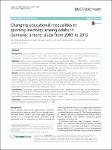Changing educational inequalities in sporting inactivity among adults in Germany: a trend study from 2003 to 2012
Hoebel, Jens
Finger, Jonas
Kuntz, Benjamin
Kroll, Lars Eric
Manz, Kristin
Lange, Cornelia
Lampert, Thomas
Background: Social inequalities in health can be explained in part by the social patterning of leisure-time physical activity, such as non-participation in sports. This study is the first to explore whether absolute and relative educational inequalities in sporting inactivity among adults have changed in Germany since the early 2000s. Methods: Data from four cross-sectional national health surveys conducted in 2003 (n = 6890), 2009 (n = 16,418), 2010 (n = 17,145) and 2012 (n = 13,744) were analysed. The study population was aged 25–69 years in each survey. Sporting inactivity was defined as no sports participation during the preceding 3 months. The regression-based Slope Index of Inequality (SII) and Relative Index of Inequality (RII) were calculated to estimate the extent of absolute and relative educational inequalities in sporting inactivity, respectively. Results: Sporting inactivity was consistently more prevalent in less-educated groups. The overall prevalence of sporting inactivity declined significantly over time. However, the decline was observed only in the high and medium education groups, while no change was observed in the low education group. Both absolute and relative educational inequalities in sporting inactivity were found to have widened significantly between 2003 (SII = 0.30, 95% CI = 0.25–0.35; RII = 2.08, 95% CI = 1.83–2.38) and 2012 (SII = 0.41, 95% CI = 0.37–0.45; RII = 3.44, 95% CI = 3.03–3.91). Interaction analysis showed that these increases in inequalities were larger in the younger population under the age of 50 than among the elderly. Conclusions: The findings suggest that the gap in sports participation between adults with high and low educational attainment has widened in both absolute and relative terms because of an increase in sports participation among the better educated. Health-enhancing physical activity interventions specifically targeted to less-educated younger adults are needed to prevent future increases in social inequalities in health.
No license information

